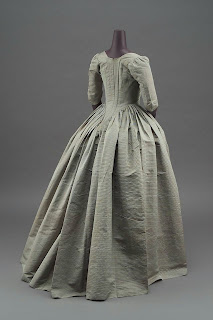This is the time period where the waist begins to rise. Many gowns have their waist emphasized by a broad sash (could the appearance of a higher waist have developed from these?). We can see the transition from the fluff of the late 1780s to the slender column of the 1800s.
Front
Closure: Closed front and Crossed v-necks
Neckline: Broad and rounded or V
Skirt opening: With Fitted bodices 8" plus, with v-necks can be none, Round gowns common
Waistline: Pointed and flat most common
Back
Style: Quarter backs most common, some English still seen
Skirt Pleats: Often less than 1/4", some with cartridge pleats
Shoulder Span: Sleeve corner very high and narrow
Sleeves
Long sleeves in two-part and Elbow length in one-part.
Trim
Sleeves: Small ruffle at hem of sleeve
Style: Mostly hem ruffle on petticoat, some trim down skirt opening
Edges: Rolled hem
Content: Self-fabric or contrast fabric
Fabric
Solid silk, cotton gauze/muslin, printed cotton, and some embroidered muslins
Shape
Waistline is rising quickly, emphasized by sashes. The bum has lost fullness, but the puffed kerchief is still common.
CWF Cotton Chintz Jacket, 1790
MFA Ribbed Silk Gown, 1790
LACMA Silk Gown, 1790-95
LACMA Muslin Gown, 1790-95
Appointment, 1792
Disappointment, 1792
Go for a Looby Go, 1792
Introduction, 1793
A Man Milliner, 1793
Damon & Delia, 1794
Emma Corbett, 1794
Summer, 1794
Autumn, 1794

















I love the chintz gown!
ReplyDeleteThis era of transition is super exciting! And I love the dawn of the "new" fashion, which is gradually anticipated.
ReplyDeleteSabine